Estes Park, Colorado.
In mid-November, we headed south for our annual trip to Arizona. On the way through Denver, we visited our photographer friend, Fred, and his wife, Ellen. Of course, we included some sites to feature here on Journeys. Last week, I shared our visit to Estes Park and the Stanley Hotel. Just outside of town is the entrance to Rocky Mountain National Park. The photo above features a view of Sprague Lake. Still not yet winter in the park, only the higher elevations were white with snow, and then only small amounts in shaded areas. The lakes were not quite yet frozen over, though they were getting there.
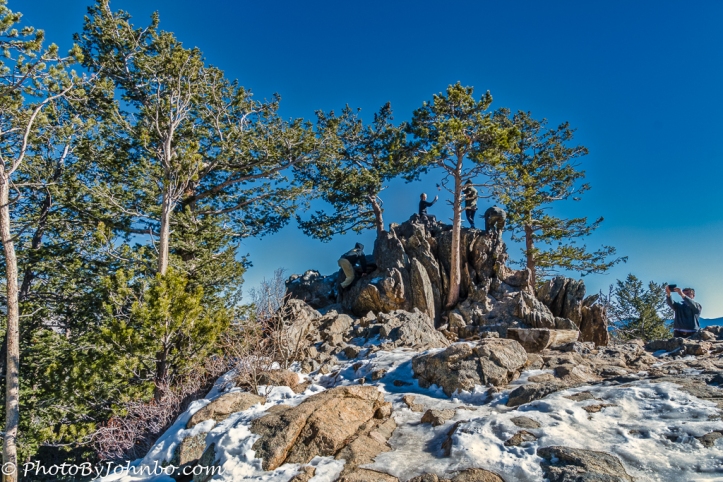 The park was relatively quiet with visitors, though it clearly wasn’t empty of anything but the large animals. Fred commented that the last time he was in the park, the meadows were filled with elk. This year, not so much. We spotted a lone elk in the park and another on the outskirts. Human presence in the park was more active with people who were out and about with their cameras taking in the beautiful scenery.
The park was relatively quiet with visitors, though it clearly wasn’t empty of anything but the large animals. Fred commented that the last time he was in the park, the meadows were filled with elk. This year, not so much. We spotted a lone elk in the park and another on the outskirts. Human presence in the park was more active with people who were out and about with their cameras taking in the beautiful scenery.
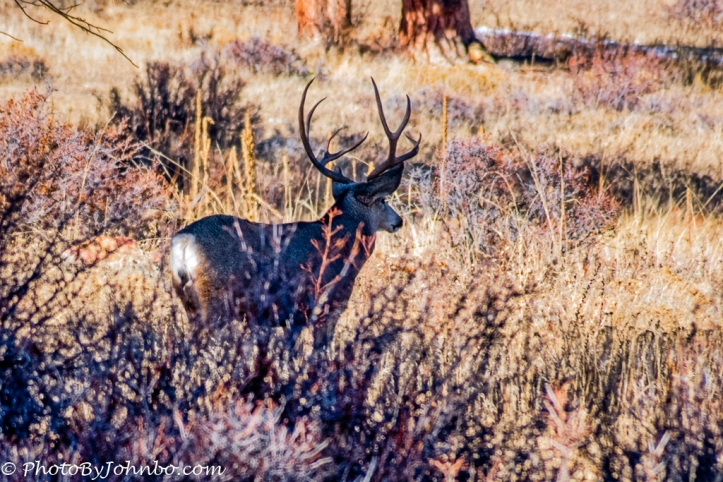 In the shade of a large tree, a bull elk stood for a few minutes. Shortly thereafter, he trotted into the sunlight and I got several photos of him crossing the meadow. Unfortunately for me, something hung up on the auto-focus on my D500 and the only properly focused shot turned out to be the one in the image above. Not sure what happened with the focus, but I’m sure it was operator error. I haven’t seen it happen before or since I captured that sequence.
In the shade of a large tree, a bull elk stood for a few minutes. Shortly thereafter, he trotted into the sunlight and I got several photos of him crossing the meadow. Unfortunately for me, something hung up on the auto-focus on my D500 and the only properly focused shot turned out to be the one in the image above. Not sure what happened with the focus, but I’m sure it was operator error. I haven’t seen it happen before or since I captured that sequence.
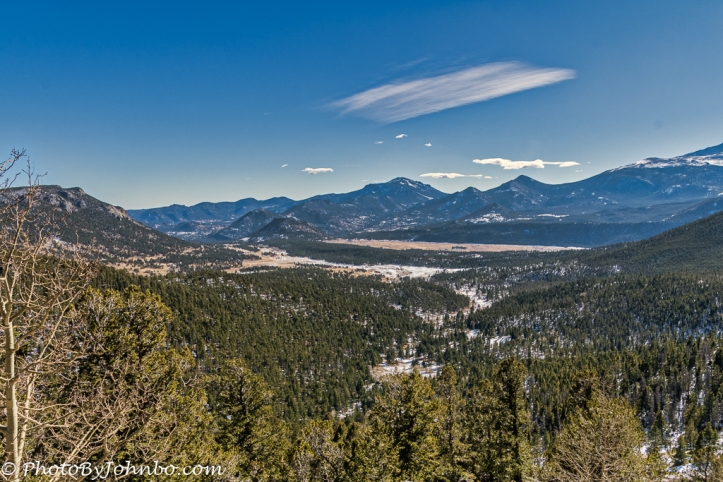 It was January 26, 1915 when Woodrow Wilson signed the Rocky Mountain National Park Act and the park was born. Today at a little over 415 square miles (1076 sq km), the park’s original 358 square miles (927 sq km) were managed with a meager budget. In the 1930s, the Civilian Conservation Corps, (CCC), constructed roads, trails and buildings as well as managing the landscape. One notable difference with this park compared to other western parks like Yellowstone, Glacier, and Grand Canyon, there was no railroad service. This park was built and served for automobile visits.
It was January 26, 1915 when Woodrow Wilson signed the Rocky Mountain National Park Act and the park was born. Today at a little over 415 square miles (1076 sq km), the park’s original 358 square miles (927 sq km) were managed with a meager budget. In the 1930s, the Civilian Conservation Corps, (CCC), constructed roads, trails and buildings as well as managing the landscape. One notable difference with this park compared to other western parks like Yellowstone, Glacier, and Grand Canyon, there was no railroad service. This park was built and served for automobile visits.
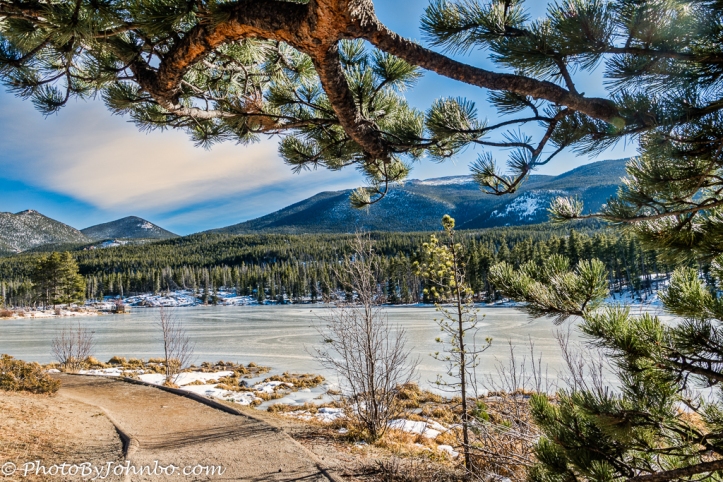 During our drive around the park, we stopped at several viewpoints, but at Sprague lake, we decided to take a short walk on one of the park’s many trails. That walk was short-lived as the first parts of the trail were in the shade and it was covered with a thick layer of polished ice. We elected to walk over to the other side of the lake and a walking trail around the lake was much more navigable. Most of the images in the gallery below feature shots captured on that walk around the lake.
During our drive around the park, we stopped at several viewpoints, but at Sprague lake, we decided to take a short walk on one of the park’s many trails. That walk was short-lived as the first parts of the trail were in the shade and it was covered with a thick layer of polished ice. We elected to walk over to the other side of the lake and a walking trail around the lake was much more navigable. Most of the images in the gallery below feature shots captured on that walk around the lake.
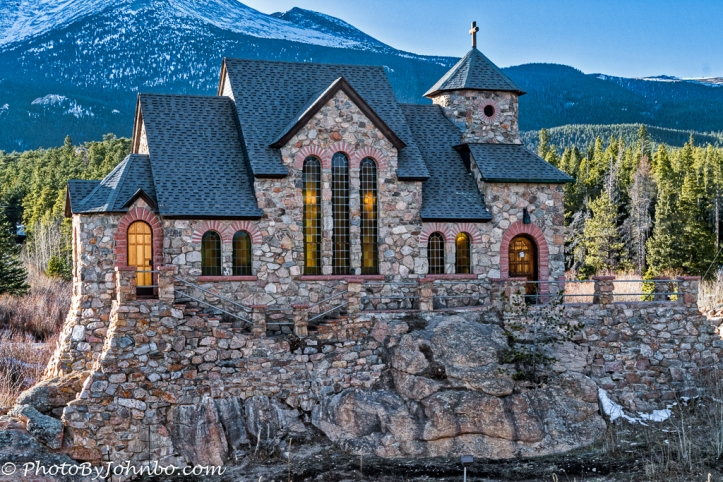 After leaving the park, we passed a beautiful church and we stopped to capture some images. My favorite is featured above. A Catholic Church, Saint Catherine of Siena Chapel, is located near the park in Allenspark, Colorado. The more well-known name of this church is “Chapel on the Rock”, completed in 1936. The Biblical phrase, “upon this rock I will build my church” was the inspiration for its construction. The large rock formation at its base became the foundation of the church envisioned by Monsignor Joseph Bosetti. You can read more about the church here.
After leaving the park, we passed a beautiful church and we stopped to capture some images. My favorite is featured above. A Catholic Church, Saint Catherine of Siena Chapel, is located near the park in Allenspark, Colorado. The more well-known name of this church is “Chapel on the Rock”, completed in 1936. The Biblical phrase, “upon this rock I will build my church” was the inspiration for its construction. The large rock formation at its base became the foundation of the church envisioned by Monsignor Joseph Bosetti. You can read more about the church here.
Background material for this post came from the Rocky Mountain National Park website here. I submit for your review a gallery of images captured in and around the park. In most browsers, you can click on an image to enlarge it and to scroll through the gallery.
John Steiner















Beautiful images from a beautiful place, John. Looks like a wildlife haven in every sense of the word.
Thanks. There are hundreds of elk in the park, but when we were there, they had moved to the high country.